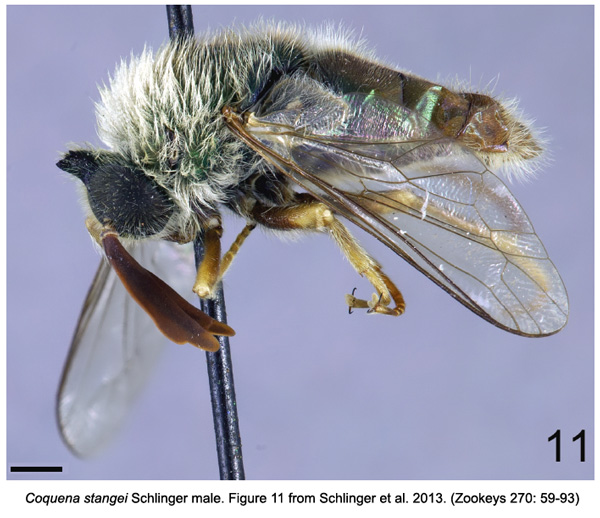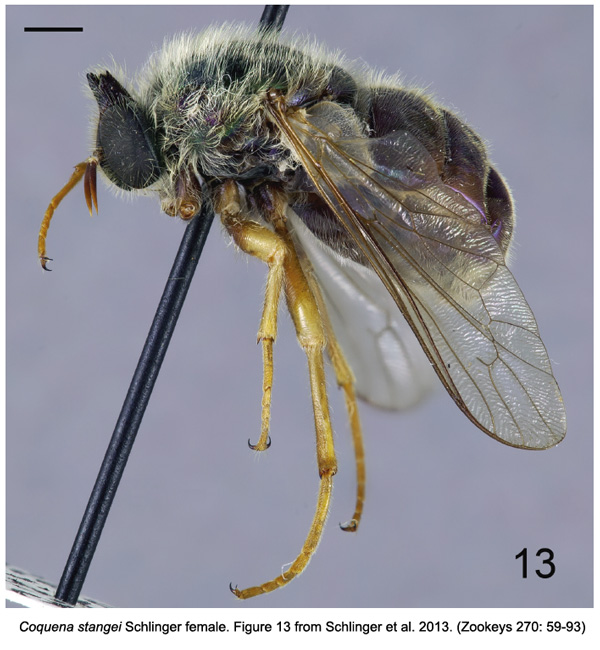Bring up flies in casual conversation and undoubtedly you’ll receive a look of disgust from your company, often followed shortly thereafter by the words “hate”, “disgusting” or “gross”. Thanks to the culturally unsavoury and occasionally deadly deeds of but a few, flies the world over are generally regarded as creatures to crush, worth more dead than alive.
Considering the media’s tendency to only get excited over new species that are fuzzy, feathered or fossilized, you could be forgiven for not realizing that more than a thousand new species of fly are described every year by taxonomists from around the world. Even other taxonomists rarely acknowledge how cool and extraordinary flies are, as they’re the only major insect order not to be selected as one of the Top 10 New Species of the Year by Arizona State University’s International Institute for Species Exploration (yet; I encourage you to nominate you’re favourite new species via the link I’ve included at the end of the post).
So welcome to what I hope will become a weekly feature, where I’ll highlight a newly described species of fly, sometimes sharing the nuances of biological nomenclature, sometimes the tireless work of taxonomists, but always the incredible diversity of Diptera. Because as Vincent Dethier concludes in his entomological exploration To Know a Fly:
To know the fly is to share a bit in the sublimity of Knowledge. That is the challenge and joy of science.
Without further ado, allow me to introduce you to Coquena stangei Schlinger:
This fantastic fly is a member of the family Acroceridae, which are commonly referred to as small-headed or spider flies (small-headed flies because many species have comically small heads; spider flies because of their fascinating natural history parasitizing spiders as mobile planidial larvae). Although we can assume that Coquena stangei is also a parasite of spiders like the rest of the species in its family, nothing specific is known about its biology or natural history, including what the male’s gigantic antennae may be used for, or why the ocellar region is so pronounced and sticking well above the rest of the head.
Coquena stangei is currently only known from one locality in northern Argentina, and was named in honour of the mythical being and protector of the animals (particularly the vicuna) of northwestern Argentina, Coquena:
Coquena was the son of Mother Earth and was portrayed as a short man dressed in a hat and bright colored poncho. The iridescent coloration, hat-like ocellar tubercle and type locality in northwest Argentina of the type species led to the choice of this name for the genus.
– Coquena stangei etymology, Schlinger et al. 2013.
While beautiful, Coquena stangei and the other 4 species described by Schlinger et al. serve as a cruel reminder that taxonomy is often a life-long pursuit, and that sometimes it takes more than one lifetime for discovered species to actually gain recognition. Evert Schlinger, the lead author on this paper and the person who will forever be associated with Coquena stangei, was a world expert on Acroceridae, and published more than 40 papers on their biology & taxonomy while a professor at the University of California, Berkeley (he was also extremely interested in biological control, particularly aphid parasitoids, and published another 40 papers on the topic). Through the course of his work, Dr. Schlinger recognized and labelled several flies housed in the California Academy of Sciences insect collection and National Museum of Natural History as new and in need of names, but was robbed of the chance to publish his work when he developed dementia. Thankfully, Jessica Gillung, an MSc student, and Dr. Chris Borkent, a post-doctoral scientist at the California Plant Pest Diagnostic Center, took it upon themselves to pick up where Dr. Schlinger left off, honouring his contributions to acrocerid taxonomy by completing and publishing this portion of his work, and including him as lead author.
Like Coquena himself, taxonomists serve as the protectors of biodiversity, and, sometimes working across generations, bring recognition to the overlooked and occasionally forgotten species living among us.
————
Nominate this species for New Species of the Year!
Schlinger E., Gillung J. & Borkent C. (2013). New spider flies from the Neotropical Region (Diptera, Acroceridae) with a key to New World genera, ZooKeys, 270 59-93. DOI: 10.3897/zookeys.270.4476 (OPEN ACCESS)



That post is just so right in so many different ways. A weekly feature about flies? Great idea. Thank you!
Such a great idea for a segment, Morgan!
Fascinating little flies. The eyes, with the little ‘periscope’ extensions, are the coolest!
Led me to understand what had happened to Evert in recent years, who once treated me to lunch in San Francisco and we talked of our mutual interests in Acroceridae.